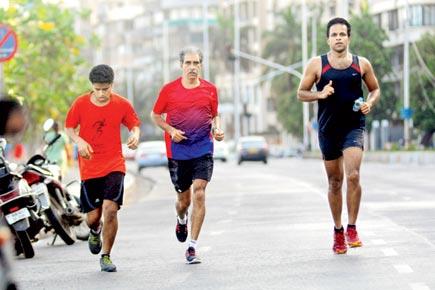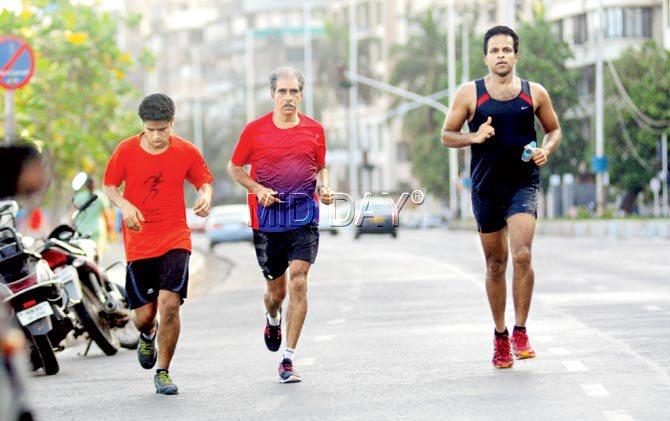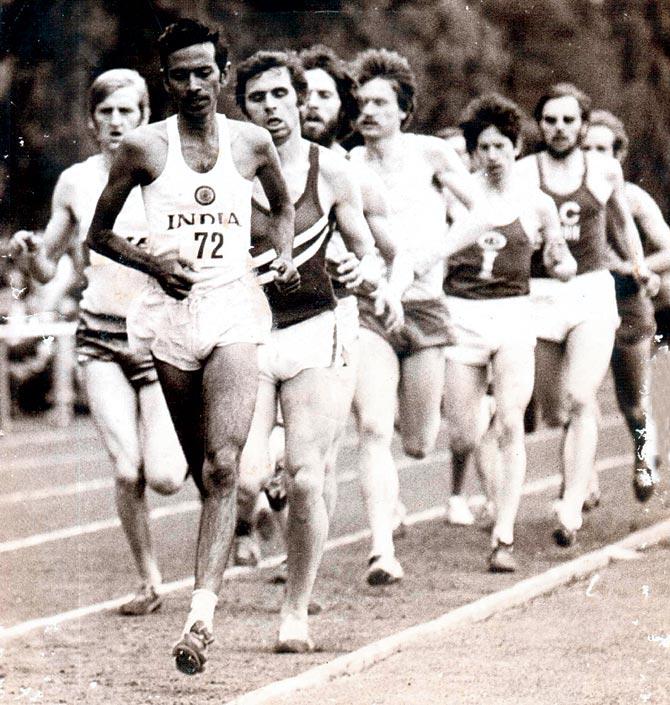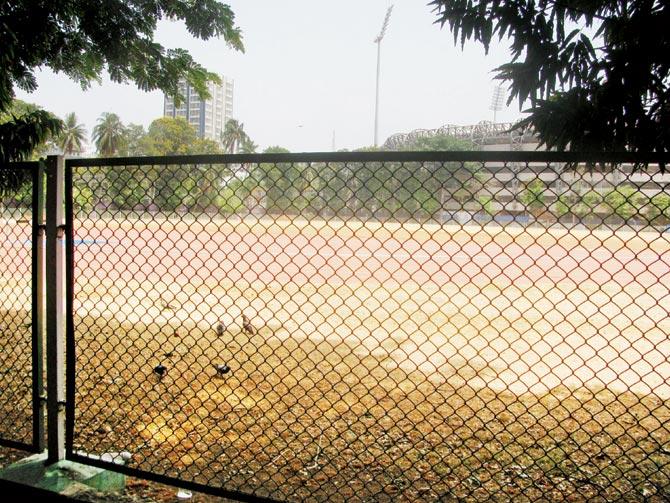A fortnight away from BNP Endurathon, a race that tests speed and pluck, we are a city producing recreational runners but no athletes. Veterans on fast feet wonder why Mumbai stopped running to win

“This is all I have. Make sure you don’t lose anything,’’ Savio D’Souza says, handing over a small file. It contains old issues of Mid-Day, Sportsweek and The Daily, and a plastic sleeve of photographs stained with age. Once, it was plump with memories of the former marathon champion’s years of running.
ADVERTISEMENT

Star distance runner from the 1980s, Savio D’Souza (centre) is one of South Mumbai’s most coveted coaches, mentoring students at Nariman Point, not very far from University Ground where he trained for free. Pic/ Bipin Kokate
Now, 61, D’Souza is a busy coach, training sprinters in a city that has become India’s running capital, ably assisted by the sponsorship spinning 12-year-old Standard Chartered Mumbai Marathon (SCMM).

Savio D’Souza (left) and Shivnath Singh during a race (By arrangement)
At the January event this year, Asian Games medallist O.P. Jaisha clocked 2 hours, 37 minutes and 29 seconds to break the women’s national record. Encouraging, except she wasn’t from Mumbai, says D’Souza with characteristic bluntness. “We have a large body of recreational runners. But where are the athletes? There was a time when Mumbai and Maharashtra produced great track and field athletes. Now, Kerala, Manipur are way ahead.”

Edward ‘Eddie’ Sequeira (front) at a race in Germany. He was a founding member of Tracktrotters club that coached running talent for free (By arrangement)
The paper clippings in D’Souza’s file date back to a time when things were different. A report dated November 24, 1986, discusses D’Souza’s performance at the Pune International Marathon, when he beat Stephen Marwa of Tanzania to second place.

Although, neither Tracktrotters or Juhu Sports Club was affiliated with the University Ground at Marine Lines, the authorities supported athletics. It was the centrepiece of old Mumbai’s athletics infrastructure. Pics courtesy/Shyam G Menon
Before that, Marwa had won two years straight. In 1984, D’Souza finished first in India and third internationally. The next year, at the Singapore International Marathon, he finished 18th, reducing his timing by a wide margin. Later, at the Hong Kong International Marathon, he was placed 13th.
The young man from Colvale in Goa graduated through 1500m, 5000m and 10,000m disciplines before he ran his first marathon. His best timing for the full marathon stands at 2:25. If he had clocked this timing at SCMM 2015, he would’ve stood sixth.
To support distance runners like him, the city spewed a range of opportunities. A November 1983 edition of Sportsweek speaks of the Runathon, a 12-km sprint through Central Mumbai, which D’Souza incidentally won. And then there were the annual Sportsweek Road Races — a series of five competitions that would throw up an overall winner. Some of Mumbai’s private and public sector companies also maintained athletics teams.
Textile giant Mafatlal, the company D’Souza worked for, had a team each for football, cricket and athletics. It wasn’t uncommon either for esteemed Mumbaikars to support athletes. Former athlete Shashi Kumar Nair remembers S.K. Wankhede, former president of the Board of Control for Cricket in India; O.V. Kuruvilla, former chairman of the Central Board of Direct Taxes and R.R. Chari, former Income Tax commissioner visiting Bombay University Sports Pavilion, popularly called University Ground, to cheer on participants.
Two fantastic sports clubs — Track trotters and Juhu Sports Club — committed coaches, an accessible track to train on and roads that would shut down for runners made Mumbai perfect ground for athletes. For Edward Sequeira, who the running community calls Eddie, the Pavilion was the centrepiece of old Mumbai’s athletics infrastructure.
A track and field facility, it welcomed Mumbai athletes from state level to Olympians. Its 400m-oval track, two curves and two straights, made it a standard. But the convergence of enthusiasts was thanks to the clubs. The middle distance runner worked as a mechanical apprentice in Central Railways, which is where he honed his running before taking it up professionally in 1959.
Sequeira, an Arjuna awardee finished eighth in the 5,000m at the 1972 Munich Olympics, and held an Asian record from 1966 in the 1,500 m, which remained unbeaten for close to 35 years. One of the founding members of Tracktrotters, he traced back its origin to the late 1950s when a group of senior athletes trained together at St Xavier’s Gymkhana, Parel.
In 1962, they became the Tracktrotters, a club that charged nothing to coach. Parents came with eager kids who wished to train, and youngsters walked in uninhibited. “Sometimes, we’d test the candidate. That was all [the scrutiny],’’ the 75-year-old Santacruz resident says. After 1969, Tracktrotters shifted its training base to University Ground.
Although neither of the two clubs or their members were affiliated to the University, the authorities supported their passion. Boxes maintained at the ground by the clubs held gear and equipment. Coaches Mervyn Jacobie, Alex Silveira, Philip Silveira, Vasant Kumar, Prithviraj Kapoor and Peter Rodrigues, all mentored free of cost. Often, a friendly competition ensued between the two. Sequeira called it the athletics ecosystem.
Jacobie is remembered as a competent coach by many. Ashok Shetty, 59, who works with the Bombay Port Trust and is a former state champion, was born into a humble family in Parel. With a friend who fared better at athletics, the boy landed up at Tracktrotters, which operated out of Khalsa College at the time. “Anyone could come and train. It was free.
The first thing Mervyn did was catch me by my ear, tell me to cut my long hair and report for training regularly,’’ Shetty recalls. It seems Jacobie’s methods wouldn’t survive today although they delivered astonishing results. He was a man of medium build; strict and insistent on punctuality.
The only day he took a break from coaching was on Sundays when he attended church. During evening training that lasted from 5 pm to 7.30 pm, it wasn’t uncommon for students to get smacked by the disciplinarian. D’Souza wasn’t spared either. On winning a race, when he went up to him to share his victory, he got a whack, instead.
“He asked me why I had turned back while running. ‘You could have run faster had you not done that’, he told me,’’ D’Souza says. Shetty remembers dropping a trophy he had bagged when Jacobie snapped at him, offering advice on how he could have been better. “The boys I was accompanied by suddenly disappeared,” he laughs.
But there was a heart behind the severe persona. When Shetty would walk from his Parel residence to University Ground because he couldn’t afford a railway pass, Jacobie wasn’t forgiving of late arrival. But when he learnt of the boy’s dilemma, he promptly paid to have his pass renewed.
Saturdays were reserved for a run on Juhu beach, with the Tracktrotters travelling to the suburb at Jacobie’s expense. “For Mervyn, coaching was life,’’ Shetty says. Select memories of the club sit on a shelf in Shashi Kumar Nair’s office housed in a building at Flora Fountain. “This shelf is now the Tracktrotters’ office,’’ he says with a wink.
In a souvenir marking the club’s 16th anniversary, which he pulls out, Jacobie had written: “Humble as the beginning was, this club had sworn to train young and enthusiastic boys and girls throughout the year, both in and off season, free of cost without any entrance fee, membership or any such formalities, irrespective of religion, caste or creed, to attain standards in athletics.
Besides providing training, these athletes are entered without any entry fee for all major athletic meets in the region; track shoes, track suits and spikes are issued to the deserving athletes, from donations received from sports lovers and friends.”
It’s this democratic approach, in dissonance with today’s commercialism, that Major Shashi Tiwari, 50, who served with the Bihar Regiment, believes helped produce champions out of nobodys. Once the national junior 800m and 1500m champion, Tiwari, who was an athlete at Tracktrotters, says, “I spent nine years there. You don’t get coaches like Mervyn anymore.”
Incidentally, that old Tracktrotters souvenir concluded with a “list of members — past and present.’’ They numbered 352. Of these, 239 or 68 per cent won medals at regional, state and national levels or had participated in international competitions. Some of them even qualified for all four levels of honour.
Sequeira pins the decline in Mumbai’s enthusiasm towards athletics to 20 years ago when the University Ground refused entry to outsiders, including the clubs and their wards. In 1982, after the Asian Games in New Delhi, the ground also served as venue for a six nation-athletic meet organised by Tracktrotters.
So, in 2011, when India was hosting the World Cup, the organisers sought an expansion of Wankhede Stadium. This would mean encroaching on a portion of the adjacent University Ground. Sequeira and Nair drummed up enough support to muzzle the move.
The ground survived, and now boasts of a modern synthetic track. Access, however, is no longer free. It’s reserved for University students or those whose applications are approved. Sequeira argues the incredulity of the claim that a city’s position in athletics can decline because a ground shut its doors to the public.
The ground had a perfect location — it sat in South Mumbai, accessible by road and rail thanks to the nearby Churchgate station. At the time, it had the city’s only track worth running on. Its open-door policy helped bolster Mumbai’s drive to catch its athletic talent young. An individual sport, it was physically demanding. “You peak early in it.
You can easily be a national champion at 16 or 18. Catching talent early is key. Restoring a ground to the public is only part of the panacea, though,” he says. The stalwarts are aware that kids today lead a life dramatically different from those in the 1960s and 70s. An interest in physical application has dipped. And a procession of distractions exist, particularly the mobile phone.
“When we trained, we weren’t allowed to speak to one another,’’ Tiwari recalls. Veteran coach, Bala Govind, points to the hurdle that academics offer. D’Souza agrees. “Studies squeeze out sports. In competitive sport, if you take a break and return, your contemporaries would have surged ahead.’’
Born in 1953, he moved to Mumbai in 1972 after clearing class 10 and got admission into Maharashtra College, Byculla, on the strength of his athletics performance. By 1976, he was representing Mumbai University in 5000m and 10,000m. “I was noticed. We used to have talent scouts who’d sniff us out, and a system that provided sustenance to dedicated sportspersons,’’ D’Souza says.
If your athletic abilities earned you a seat at college, your continued excellence bagged you a job at a prestigious firm. “I’d be away seven to eight months of the year, training and competing. And I’d receive a regular salary,’’ says Sequeira, who held a job at Tata Steel.
If his memory serves him, in 1982, the Tata Group had within its fold six world champions, five Olympic medal winners, four Commonwealth Games medal winners, 36 Asian Games medal holders, 33 Asian Championship medal holders, 41 Arjuna awardees, 51 Olympians, 54 Asian Championships participants, one Padma Bhushan and 11 Padma Sri for sports recipients.
While public sector firms continue their policy of supporting sports through employment, the private sector picks results over support, especially in sports that enjoy visibility. But D’Souza says for efforts to bear spectacular results of the past, we need to start young, at school.
Sequeira suggests we bring back the old races. “Rain or no rain, the Oval Maidan is available; Marine Drive is too. Why have one marathon a year? And let’s forget about the seniors and focus on the juniors.’’ He hopes corporate sponsors will come forward to support a junior athletics meet.
There’s reason behind his hope. He, together with Nair, is working towards planning a Tracktrotters comeback. The club held its general body meeting recently, which was attended by 60 members. “We commit to try and regain the old glory of Mumbai athletics,’’ says Nair, the club’s vice president.
The two hope to return to the splendor described best in a Sportsweek report dated 1983 on the Runathon: “Police Commissioner Julio Ribeiro in a dashing Bombay Police track-suit set the big field (491 to be exact) off from Shivaji Park at 7 am. Though the start was together in the classic Boston Marathon style, for the different groups, the race was terminated at different stages of the course. At one stage, the runners were strung out from Dadar, down to Parel and Lalbaug, over Currey Road and Lower Parel bridges and into the homestretch.
The traffic police and the Naigaum police co-operated throughout in keeping the roads reasonably clear for the runners. Savio D’Souza, Bombay’s and Mafatlal’s ace runner led the field right through, at first a few lengths ahead, then more, finally striding almost alone, king of the road.
There were runners from Track Trotters, Atomic Energy Central School, St Sebastians of Dabul, Young Athletic Club, Customs and Income Tax. Captain Reza Beg of Air India was there. The day before, he was jogging in Tokyo. On Sunday, he took off with the rest of the runners from Shivaji Park.
Course completed, he carefully logged his personal time in a logbook. The regular early morning Shivaji Park joggers and walkers joined in, including a 76 year old-veteran. Later a special prize was announced for him but he had disappeared. The prizes ranged from sports scholarships to silver cups, Hot-Shot cameras and other items. Bombay has started running for fun. Perhaps a little behind the rest of the world, but it has started.’’
(The original version of this article first appeared on Outrigger-WordPress.com)
 Subscribe today by clicking the link and stay updated with the latest news!" Click here!
Subscribe today by clicking the link and stay updated with the latest news!" Click here!






